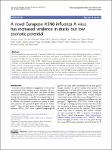A novel European H5N8 influenza A virus has increased virulence in ducks but low zoonotic potential
Grund, Christian
Hoffmann, Donata
Ulrich, Reiner
Naguib, Mahmoud
Schinköthe, Jan
Hoffmann, Bernd
Harder, Timm
Saenger, Sandra
Zscheppang, Katja
Tönnies, Mario
Hippenstiel, Stefan
Hocke, Andreas
Wolff, Thorsten
Beer, Martin
We investigated in a unique setup of animal models and a human lung explant culture biological properties, including zoonotic potential, of a representative 2016 highly pathogenic avian influenza virus (HPAIV) H5N8, clade 2.3.4.4 group B (H5N8B), that spread rapidly in a huge and ongoing outbreak series in Europe and caused high mortality in waterfowl and domestic birds. HPAIV H5N8B showed increased virulence with rapid onset of severe disease and mortality in Pekin ducks due to pronounced neuro- and hepatotropism. Cross-species infection was evaluated in mice, ferrets, and in a human lung explant culture model. While the H5N8B isolate was highly virulent for Balb/c mice, virulence and transmissibility were grossly reduced in ferrets, which was mirrored by marginal replication in human lung cultures infected ex vivo. Our data indicate that the 2016 HPAIV H5N8B is avian-adapted with augmented virulence for waterfowl, but has low zoonotic potential. The here tested combination of animal studies with the inoculation of human explants provides a promising future workflow to evaluate zoonotic potential, mammalian replication competence and avian virulence of HPAIV.
Dateien zu dieser Publikation

